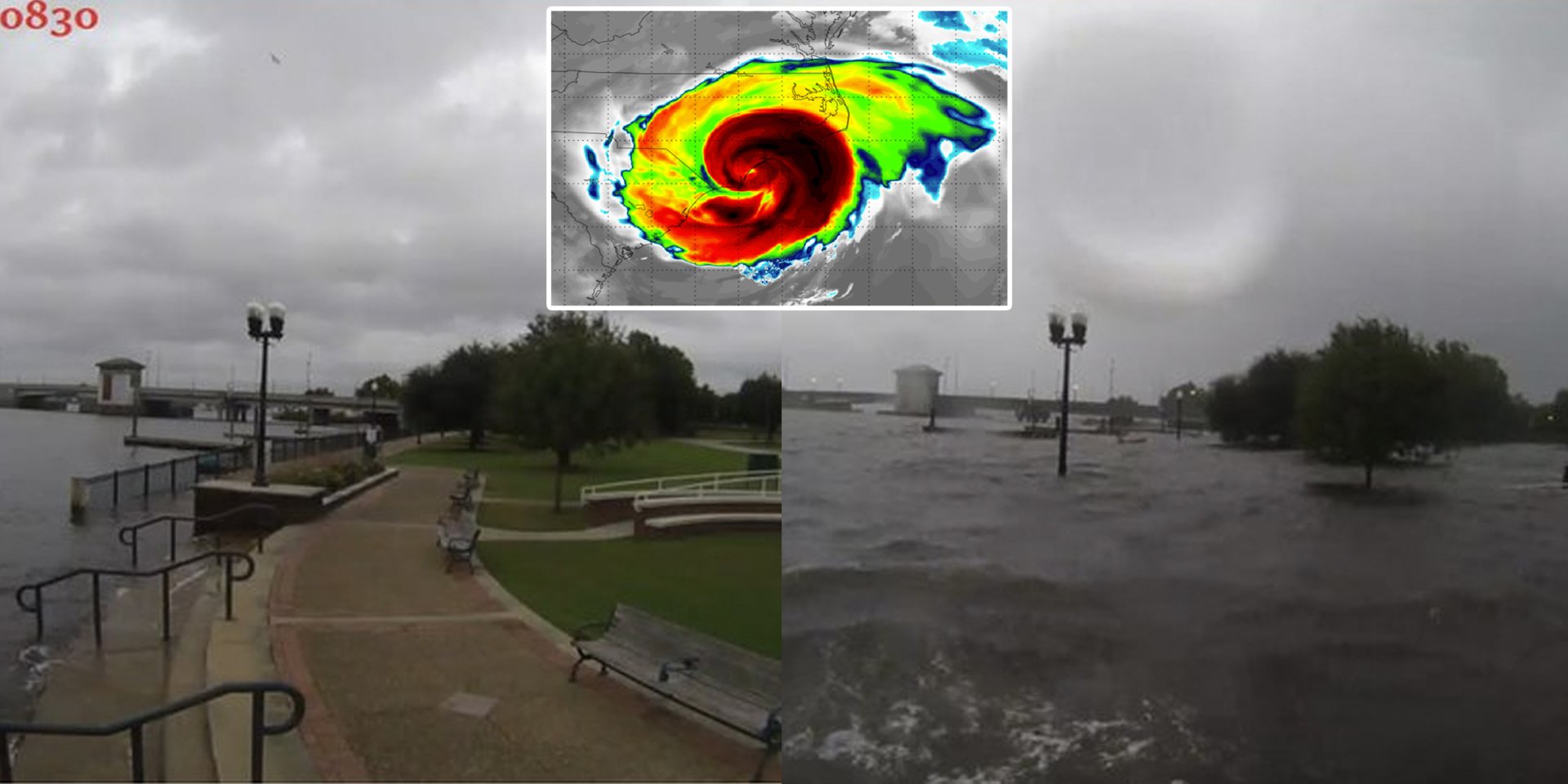Hurricane Florence has been downgraded to a tropical storm, but its strong wind and heavy rain are still battering the Carolinas. The center of the storm moved toward eastern South Carolina on Friday night, hours after making landfall at Wrightsville Beach, North Carolina, hours earlier.
The storm has killed at least five people in North Carolina.
A mother and baby died when a tree crashed into their home, the Wilmington Police Department said on Twitter Friday afternoon. A 78-year-old man was killed while trying to connect two extension cords outside in the rain, ABC News reported citing Lenoir County Emergency Services Director Roger Dail.
The storm was also implicated in the death of a woman who suffered a heart attack, since emergency crews couldn’t reach her due to a fallen tree, as The Wall Street Journal reported. And a man was blown away by strong winds while outside checking on his dogs. The man’s family found his body Friday morning, according to Dail.
Winds up to 70 mph are still lashing the coast, and a storm surge up to 12 feet high is expected in some areas, according to the National Hurricane Center (NHC). The storm could drop up to 40 inches of rain in some spots, causing “catastrophic” floods and a “life-threatening” situation, the NHC said.
So far, floods as deep as 6.3 feet have been recorded.
The storm was giant when it made landfall: hurricane-force winds extended outward up to 80 miles, and tropical-storm-force winds extended nearly 200 miles from the storm’s center.
Ken Graham, director of the National Hurricane Center, said Florence has been “nearly stationary on the coast for several hours” on Friday.
The storm is moving at a walker’s pace, just 3 mph, and is expected to dump rain on the Carolinas for days. Homes have flooded and trees crashed through rooftops.
“Landfall of a hurricane is never the end of the event,” Weather Channel meteorologist and hurricane expert Rick Knabb said on Friday. “Slow-moving Florence is not even close to being done with the coast.”
Florence is forecast to dump about 18 trillion gallons of rain over North Carolina, South Carolina, Virginia, Georgia, Tennessee, Kentucky, and Maryland before the storm is over. That’s enough water to fill the Chesapeake Bay or to cover the state of Texas in 4 inches.
Read more: Why Hurricane Florence could dump so much water on the Carolinas
In North Carolina, more than 788,000 homes are without power, according to the North Carolina Department of Public Safety. The US Department of Energy estimates that number accounts for about 13% of the state’s customers.
Nearly 150,000 homes in South Carolina are disconnected, according to poweroutage.us, a website that collects outage data from across the country. The number of darkened homes is only expected to get worse over the weekend.
Footage from North Carolina shows massive flooding and high winds
These images, recorded by a camera maintained by the HurricaneTracker.com website in the riverfront town of New Bern, North Carolina, showed the dramatic progress of flooding on Thursday and Friday. The water consumed most of the Union Point river bank area by Thursday evening.
Other photos and videos shared on social media also showed dangerous conditions in North Carolina.
Although Florence’s wind speed means it is now a tropical storm, the NHC has consistently warned that the storm will not get less dangerous as the wind speed falls, since bigger threats come from the rain and floods.
People survey the damage caused by Hurricane Florence on Front Street in downtown New Bern, North Carolina, on Friday, Sept. 14, 2018. AP Photo/Chris Seward
On Friday, the storm toppled roofs and trees.
Branches crashed into this home in Wilmington, North Carolina while three people were inside. One man there was critically injured and taken away on a stretcher.
The wet and windy conditions were less of a problem for this pair of dolphins seen swimming nearby.
This timelapse shows how much rain fell in just a four-hour period in the coastal city of Oriental, North Carolina.
The most extreme conditions could be seen on the Outer Banks of North Carolina and on riverfront cities that were were hit hard by storm surge waters forced inland. A federal rain gauge in Emerald Isle, a town on a sandbank just north of Wilmington, recorded 6.6 feet of flood water.
Millions of people are affected
North Carolina Governor Roy Cooper dispatched over 2,800 National Guard soldiers in the state.
“We know this massive storm will cause incredible damage” he said on Thursday. “Surviving this storm will be a test of endurance, teamwork, common sense and patience.”
On Friday morning, rescue workers loaded boats and trucks in the North Carolina river town of James City, near New Bern, and started evacuating people and their pets.
Rescue workers from Township No. 7 Fire Department and volunteers from the Civilian Crisis Response Team help rescue a woman and her dog from their flooded home during Hurricane Florence September 14, 2018 in James City, North Carolina. Chip Somodevilla/Getty Images
For those whose homes are being flooded, the National Weather Service says to move up to higher floors in your house and take your phone and supplies. Stay away from attics and crawl spaces where you could get trapped. If the water rises too high to stay inside, get to the roof.
Governors of five states declared states of emergency ahead of the storm: North Carolina, South Carolina, Virginia, Georgia, and Maryland. Mandatory evacuation orders were in place in coastal areas of North Carolina, South Carolina, and Virginia, affecting a total of about 1.7 million people, according to the Associated Press. The homes of more than 10 million people were under official watches or warnings for hurricane or tropical storm conditions.
In North Carolina, more than 12,000 people fleeing the storm are staying dry at 126 shelters located across the state.
Sinéad Baker, Alexandra Ma, Hilary Brueck, and Bryan Logan contributed reporting.









